Assessing Agricultural Water Productivity in Desert Farming System of Saudi Arabia

Authors:
The primary objective of this study was to assess the water productivity (WP) of the annual (wheat, barley, and corn) and biennial (alfalfa and Rhodes grass) crops cultivated under centerpivot irrigation located over desert areas of the Al-Kharj region in Saudi Arabia. The Surface Energy Balance Algorithm for Land (SEBAL) was applied to Advanced Spaceborne Thermal Emission and Reflection Radiometer (ASTER) images to obtain evapotranspiration (ET) for assessing WP and irrigation performance (IP) of crops. Crop productivity (CP) was estimated using Normalized Difference Vegetation Index (NDVI) crop productivity models. The predicted CP (CPP) for corn varied from 12 690 to 14 060 kg/ha and from 6000 to 7370 kg/ha for wheat. The for alfalfa and Rhodes grass was 42 450 and 58 210 (kg/ha/year), respectively. The highest predicted WP was observed in wheat (0.80-2.01 kg/m3) and the lowest was in alfalfa (0.38-0.46 kg/m3). The deviation between SEBAL predicted ET (ETP) and weather station recorded ET (ETW) was 10%. The performance of the prediction models was assessed against the measured data. The overall mean bias/error of the predictions of CP, ET, and WP was 9.4%, , and 9.65%, respectively; the root mean square error (RMSE) was 1996 (kg/ha), 2107 (m3/ha), and 0.09 (kg/m3) for CP, ET, and WP, respectively. When CP was converted into variations between the actual and predicted, the variations were 8% to 12% for wheat, 14% to 20% for corn, 17% to 35% for alfalfa, 3% to 38% for Rhodes grass, and 4% for barley.
